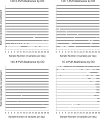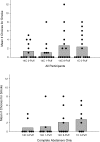Effects of initial abstinence and programmed lapses on the relative reinforcing effects of cigarette smoking
- PMID: 19192854
- PMCID: PMC2606599
- DOI: 10.1901/jaba.2008.41-481
Effects of initial abstinence and programmed lapses on the relative reinforcing effects of cigarette smoking
Abstract
Fifty-eight smokers received abstinence-contingent monetary payments for 1 (n=15) or 14 (n=3) days. Those who received contingent payments for 14 days also received 0, 1, or 8 experimenter-delivered cigarette puffs on 5 evenings. The relative reinforcing effects of smoking were assessed in a 3-hr session on the final study day, when participants made 20 choices between smoking or money. The reinforcement contingencies exerted robust control over smoking, and programmed smoking lapses produced few discernible effects. These results further illustrate the robust control that reinforcement contingencies can exert over cigarette smoking and suggest that any effects of lapses on the relative reinforcing effects of smoking are modest under conditions involving abstinence-contingent reinforcement contingencies.
Figures






References
-
- Alessi S.M, Badger G.J, Higgins S.T. An experimental examination of the initial weeks of abstinence in cigarette smokers. Experimental and Clinical Psychopharmacology. 2004;12((4)):276–287. - PubMed
-
- Annual smoking-attributable mortality, years of potential life lost, productivity losses—United States 1997–2001. Morbidity and Mortality Weekly Report. 2005 Jul 1;54:625–628. - PubMed
-
- Chornock W.M, Stitzer M.L, Gross J, Leischow S. Experimental model of smoking re-exposure: Effects on relapse. Psychopharmacology. 1992;108((4)):495–500. - PubMed
-
- Cigarette smoking among adults—United States, 2004. Morbidity and Mortality Weekly Report. 2005 Nov 11;54:1121–1124. - PubMed
Publication types
MeSH terms
Grants and funding
LinkOut - more resources
Full Text Sources
Medical

